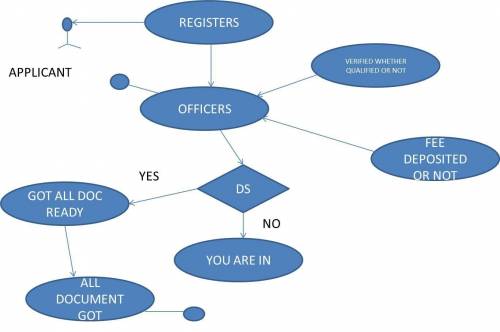How to draw use case diagram
when an applicant requests to register for a course, an officer f...

Computers and Technology, 17.12.2019 15:31 bree480
How to draw use case diagram
when an applicant requests to register for a course, an officer from student affairs verifies whether he/she has relevant entry qualifications and paid the fees. if certificates to show entry qualifications are not brought the applicant is asked to bring them and return. if the fees are not paid the applicant is directed to the finance division to make the payment and come. to register for a course, the system checks whether the course prerequisites are satisfied and let the student register for the particular course.
a student is given a student id number and a registration number for the particular programme. all courses have unique course codes, titles, credit ratings and a set of pre-requisites.
how to draw use case diagram

Answers: 3


Other questions on the subject: Computers and Technology

Computers and Technology, 21.06.2019 13:30, jessicascott120305
In mmf2, what is the grid? a. a toolbar that lets you open libraries and use the objects in them in your games b. an object that creates the background or other scenery for a game c. a set of vertical and horizontal lines that are usually invisible in the play area d. a set of vertical and horizontal lines that are usually visible in the play area
Answers: 1

Computers and Technology, 24.06.2019 06:00, bzhsh8282
Hey i really need some solving this problem: 1. encrypt this binary string into cipher text: 110000. include in your answer the formula the decoder would use to decrypt your cipher text in the format (coded answer) x n mod (m) = y & 2. decrypt this cipher text into a binary string: 106 you.
Answers: 2

Computers and Technology, 24.06.2019 07:00, AnaiyaKirksey8
You are most likely to automatically encode information about
Answers: 1

Computers and Technology, 24.06.2019 14:40, drecooks713
Create a function (prob3_6) that will do the following: input a positive scalar integer x. if x is odd, multiply it by 3 and add 1. if the given x is even, divide it by 2. repeat this rule on the new value until you get 1, if ever. your program will output how many operations it had to perform to get to 1 and the largest number along the way. for example, start with the number 3: because 3 is odd, we multiply by 3 and add 1 giving us 10. 10 is even so we divide it by 2, giving us 5. 5 is odd so we multiply by 3 and add one, giving us 16. we divide 16 (even) by two giving 8. we divide 8 (even) by two giving 4. we divide 4 (even) by two giving 2. we divide 2 (even) by 2 to give us 1. once we have one, we stop. this example took seven operations to get to one. the largest number we had along the way was 16. every value of n that anyone has ever checked eventually leads to 1, but it is an open mathematical problem (known as the collatz conjectureopens in new tab) whether every value of n eventually leads to 1. your program should include a while loop and an if-statement.
Answers: 3
You know the right answer?
Questions in other subjects:

Mathematics, 03.07.2019 00:50

History, 03.07.2019 00:50

History, 03.07.2019 00:50

Social Studies, 03.07.2019 00:50





Chemistry, 03.07.2019 00:50




